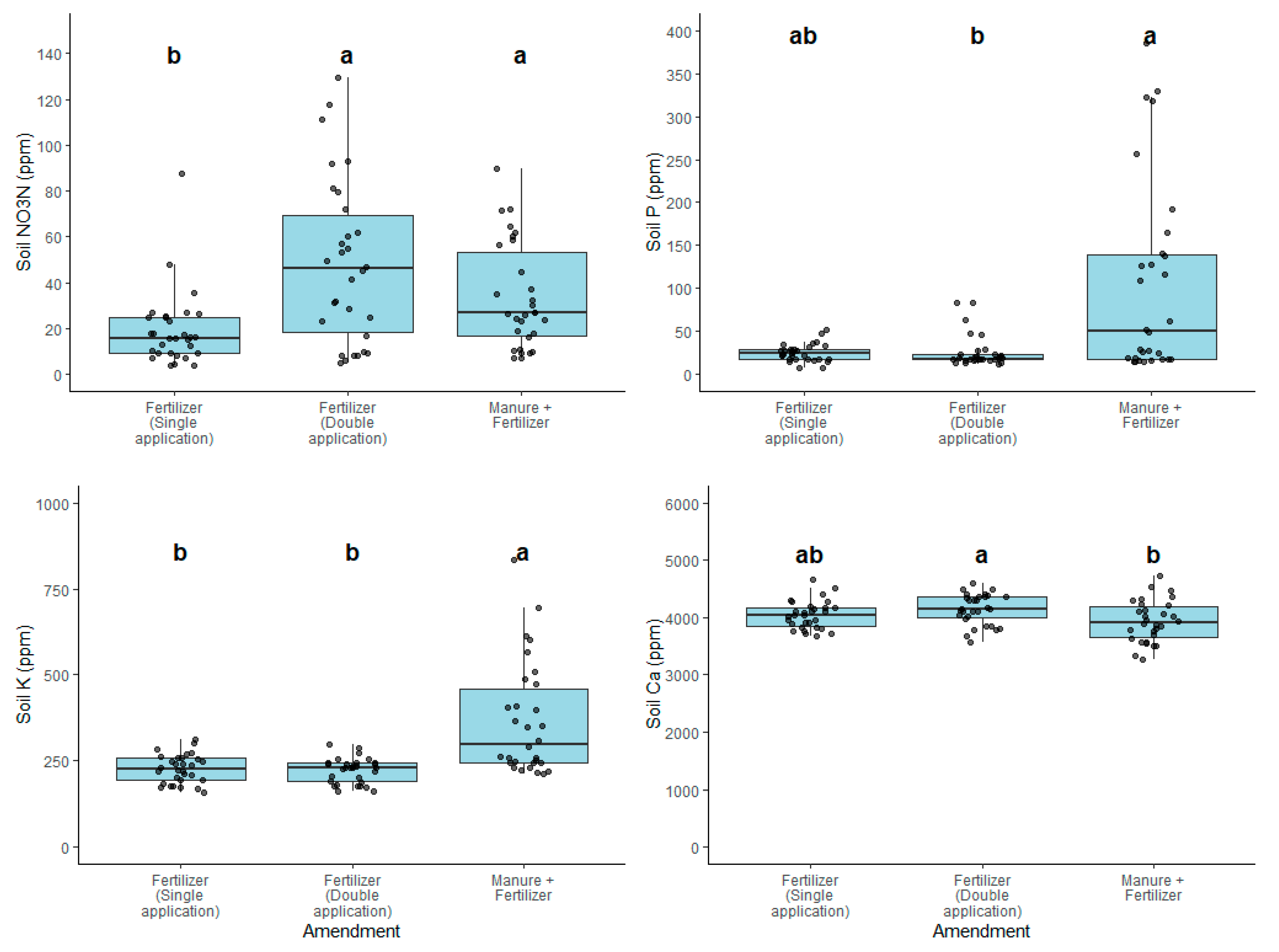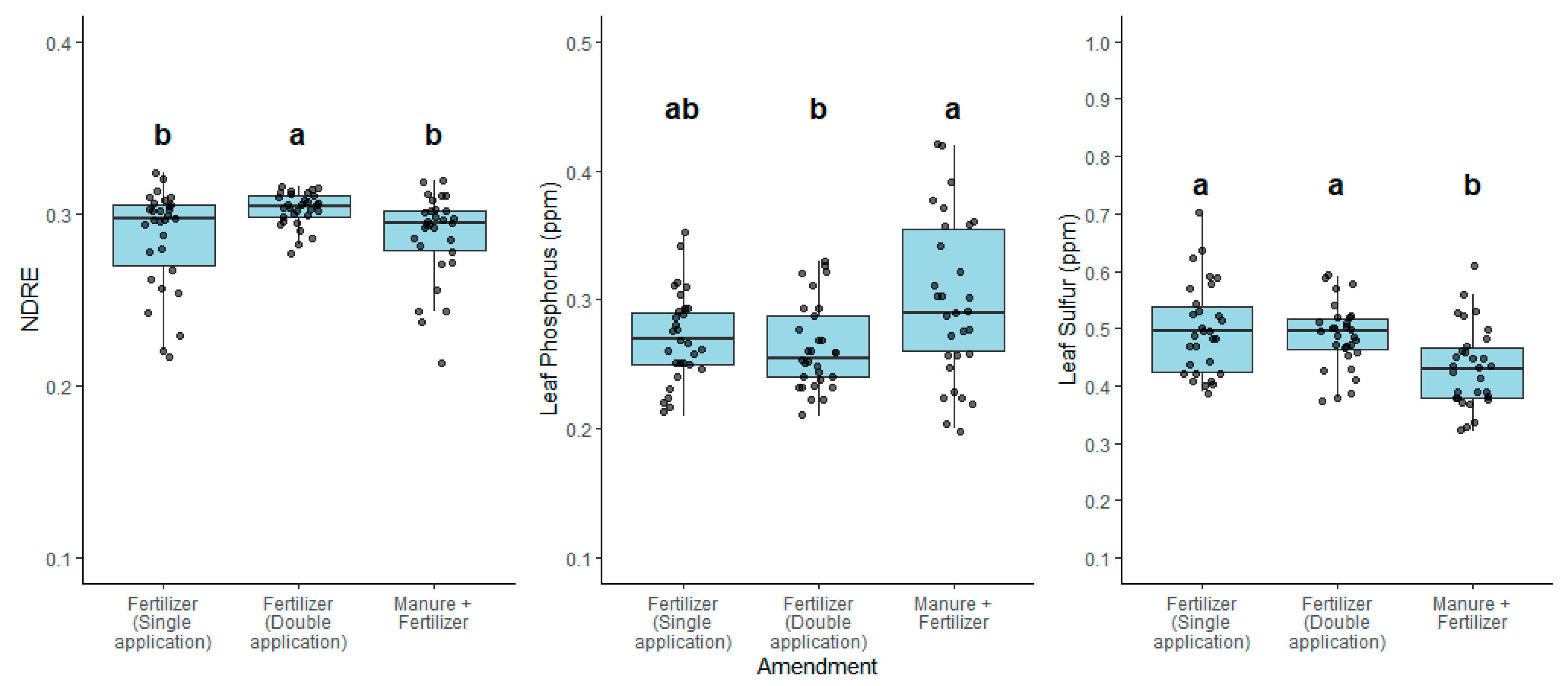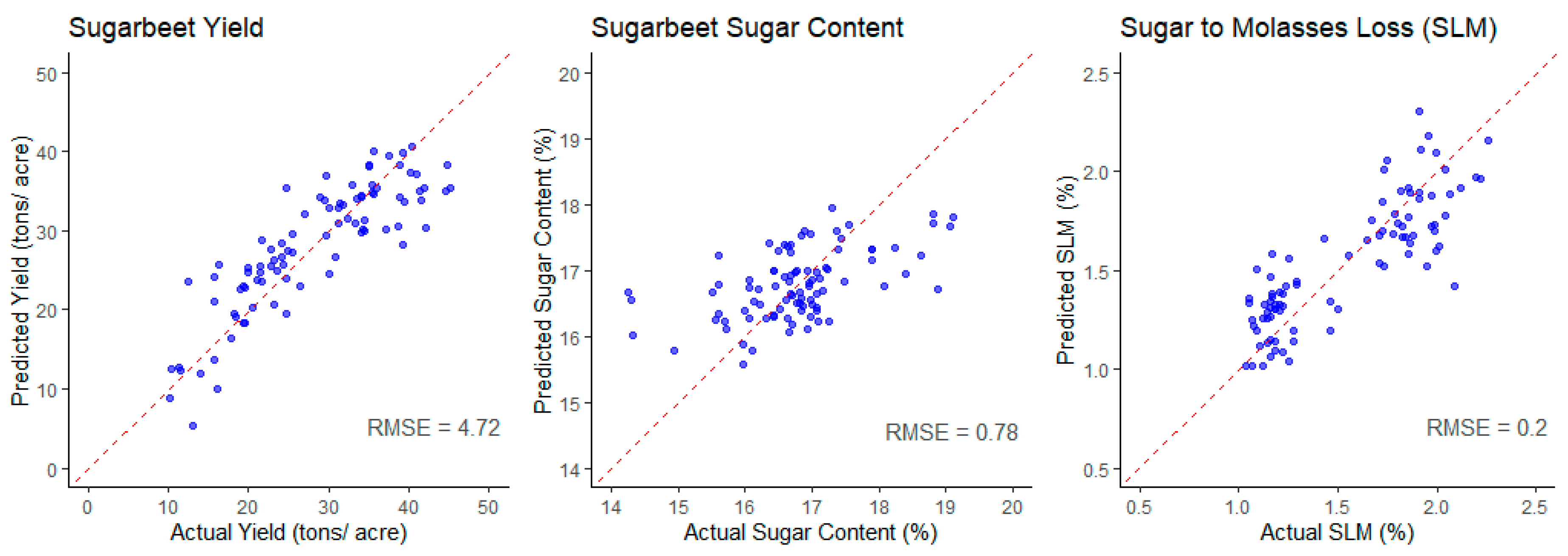Effects of Char and Amendments on Soil Properties and Sugar Beet Yield in Sandy Clay Loam Soil
Abstract
1. Introduction
2. Materials and Methods
2.1. Study Area
2.2. Experimental Design
2.3. Char and Manure Application
2.4. Soil Sampling
2.5. Plant Growth Indices Measurement and Leaf Sampling
2.6. Beet Root Harvesting
2.7. Statistical Analyses
3. Results
3.1. Characteristics of Coal Char, Biochar, and Manure Used in the Study
3.2. Impact of Char Treatment and Fertilizer Amendment on Soil Properties
3.3. Impact of Char Treatment and Fertilizer Amendment on Soil Nutrients
3.4. Impact of Char Treatment and Fertilizer Amendment on Vegetation Indices
3.5. Impact of Char Treatment and Fertilizer Amendment on Plant Nutrients
3.6. Impact of Char Treatment and Amendment on Yield and Quality of Sugar Beet
4. Discussions
4.1. Impact of Char Treatment and Amendment on Soil and Plant Covariates
4.2. Impact of Char Treatment and Amendment on Sugar Beet Yield and Quality
5. Conclusions
Author Contributions
Funding
Data Availability Statement
Acknowledgments
Conflicts of Interest
References
- Joseph, S. Biochar for Environmental Management: Science, Technology and Implementation; Routledge: Abingdon, UK, 2015. [Google Scholar]
- Jeffery, S.; Verheijen, F.G.A.; van der Velde, M.; Bastos, A.C. A Quantitative Review of the Effects of Biochar Application to Soils on Crop Productivity Using Meta-Analysis. Agric. Ecosyst. Environ. 2011, 144, 175–187. [Google Scholar] [CrossRef]
- Cooper, J.A.; Drijber, R.A.; Malakar, A.; Jin, V.L.; Miller, D.N.; Kaiser, M. Evaluating Coal Char as an Alternative to Biochar for Mitigating Nutrient and Carbon Loss from Manure-Amended Soils: Insights from a Greenhouse Experiment. J. Environ. Qual. 2022, 51, 272–287. [Google Scholar] [CrossRef] [PubMed]
- Thapa, R.B.; Budhathcoki, S.; Shilpakar, C.; Panday, D.; Alsunuse, B.; Tang, S.X.; Stahl, P.D. Enhancing Corn Yield and Soil Quality in Irrigated Semiarid Region with Coal Char and Biochar Amendments. Soil Syst. 2024, 8, 82. [Google Scholar] [CrossRef]
- Panday, D.; Mikha, M.M.; Sun, X.; Maharjan, B. Coal Char Effects on Soil Chemical Properties and Maize Yields in Semi-Arid Region. Agrosystems Geosci. Environ. 2021, 4, e20145. [Google Scholar] [CrossRef]
- Thapa, R.B.; Tang, S.X.; Stahl, P.D. Initial Greenhouse Observations on Use of Coal Char as a Soil Amendment: Influences on Plant Growth and Soil Water Holding Capacity. J. Dryland Agric. 2024, 10, 7–14. [Google Scholar]
- Hoffmann, C.M.; Kenter, C. Yield Potential of Sugar Beet—Have We Hit the Ceiling? Front. Plant Sci. 2018, 9, 289. [Google Scholar] [CrossRef]
- Vaccari, F.P.; Baronti, S.; Lugato, E.; Genesio, L.; Castaldi, S.; Fornasier, F.; Miglietta, F. Biochar as a Strategy to Sequester Carbon and Increase Yield in Durum Wheat. Eur. J. Agron. 2011, 34, 231–238. [Google Scholar] [CrossRef]
- Glaser, B.; Lehmann, J.; Zech, W. Ameliorating Physical and Chemical Properties of Highly Weathered Soils in the Tropics with Charcoal—A Review. Biol. Fertil. Soils 2002, 35, 219–230. [Google Scholar] [CrossRef]
- Hammer, E.C.; Balogh-Brunstad, Z.; Jakobsen, I.; Olsson, P.A.; Stipp, S.L.S.; Rillig, M.C. A Mycorrhizal Fungus Grows on Biochar and Captures Phosphorus from Its Surfaces. Soil Biol. Biochem. 2014, 77, 252–260. [Google Scholar] [CrossRef]
- Abou Hussien, E.A.; Shalaby, M.H.; Alshahri, B.S.O. Utilizing Compost and Biochar in Enhancing Phytoremediation of Contaminated Soil. Menoufia J. Soil Sci. 2020, 5, 201–213. [Google Scholar] [CrossRef]
- Li, Y.; Yao, N.; Liang, J.; Wang, X.; Jia, Y.; Jiang, F.; Liu, D.L.; Hu, W.; He, H.; Javed, T. Optimum Biochar Application Rate for Peak Economic Benefit of Sugar Beet in Xinjiang, China. Agric. Water Manag. 2022, 272, 107880. [Google Scholar] [CrossRef]
- Liang, J.; Li, Y.; Si, B.; Wang, Y.; Chen, X.; Wang, X.; Chen, H.; Wang, H.; Zhang, F.; Bai, Y.; et al. Optimizing Biochar Application to Improve Soil Physical and Hydraulic Properties in Saline-Alkali Soils. Sci. Total Environ. 2021, 771, 144802. [Google Scholar] [CrossRef] [PubMed]
- Major, J.; Rondon, M.; Molina, D.; Riha, S.J.; Lehmann, J. Maize Yield and Nutrition during 4 Years after Biochar Application to a Colombian Savanna Oxisol. Plant Soil 2010, 333, 117–128. [Google Scholar] [CrossRef]
- Akhtar, S.S.; Li, G.; Andersen, M.N.; Liu, F. Biochar Enhances Yield and Quality of Tomato under Reduced Irrigation. Agric. Water Manag. 2014, 138, 37–44. [Google Scholar] [CrossRef]
- Bai, S.H.; Omidvar, N.; Gallart, M.; Kämper, W.; Tahmasbian, I.; Farrar, M.B.; Singh, K.; Zhou, G.; Muqadass, B.; Xu, C.Y.; et al. Combined Effects of Biochar and Fertilizer Applications on Yield: A Review and Meta-Analysis. Sci. Total Environ. 2022, 808, 152073. [Google Scholar] [CrossRef]
- Liu, Q.; Zhang, Y.; Liu, B.; Amonette, J.E.; Lin, Z.; Liu, G.; Ambus, P.; Xie, Z. How Does Biochar Influence Soil N Cycle? A Meta-Analysis. Plant Soil 2018, 426, 211–225. [Google Scholar] [CrossRef]
- Ye, L.; Camps-Arbestain, M.; Shen, Q.; Lehmann, J.; Singh, B.; Sabir, M. Biochar Effects on Crop Yields with and without Fertilizer: A Meta-Analysis of Field Studies Using Separate Controls. Soil Use Manag. 2020, 36, 2–18. [Google Scholar] [CrossRef]
- Alves, B.S.Q.; Zelaya, K.P.S.; Colen, F.; Frazão, L.A.; Napoli, A.; Parikh, S.J.; Fernandes, L.A. Effect of Sewage Sludge and Sugarcane Bagasse Biochar on Soil Properties and Sugar Beet Production. Pedosphere 2021, 31, 572–582. [Google Scholar] [CrossRef]
- Lebrun, M.; Bouček, J.; Bímová, K.B.; Kraus, K.; Haisel, D.; Kulhánek, M.; Omara-Ojungu, C.; Seyedsadr, S.; Beesley, L.; Soudek, P.; et al. Biochar in Manure Can Suppress Water Stress of Sugar Beet (Beta Vulgaris) and Increase Sucrose Content in Tubers. Sci. Total Environ. 2022, 814, 15772. [Google Scholar] [CrossRef]
- Durukan, H.; Demirbas, A.; Turkekul, I. Effects of Biochar Rates on Yield and Nutrient Uptake of Sugar Beet Plants Grown under Drought Stress. Commun. Soil Sci. Plant Anal. 2020, 51, 2735–2745. [Google Scholar] [CrossRef]
- Thapa, R.B.; Coupal, R.H.; Dangi, M.B.; Stahl, P.D. An Assessment of Plant Growth and Soil Properties Using Coal Char and Biochar as a Soil Amendment. Agronomy 2024, 14, 320. [Google Scholar] [CrossRef]
- Maharjan, B.; Panday, D.; Blanco-Canqui, H.; Mikha, M.M. Potential Amendments for Improving Productivity of Low Carbon Semiarid Soil. Agrosystems Geosci. Environ. 2021, 4, e20171. [Google Scholar] [CrossRef]
- Blanco-Canqui, H.; Kaiser, M.; Hergert, G.W.; Creech, C.F.; Nielsen, R.; Maharjan, B.; Easterly, A.C.; Lawrence, N.C. Can Char Carbon Enhance Soil Properties and Crop Yields in Low-Carbon Soils? J. Environ. Qual. 2020, 49, 1251–1263. [Google Scholar] [CrossRef]
- Panday, D.; Mikha, M.M.; Collins, H.P.; Jin, V.L.; Kaiser, M.; Cooper, J.; Malakar, A.; Maharjan, B. Optimum Rates of Surface-Applied Coal Char Decreased Soil Ammonia Volatilization Loss. J. Environ. Qual. 2020, 49, 256–267. [Google Scholar] [CrossRef] [PubMed]
- Sousa, M.G.; Araujo, J.K.S.; Fracetto, G.G.M.; Ferreira, T.O.; Fracetto, F.J.C.; de Araújo Filho, J.C.; Otero, X.L.; dos Santos, J.C.B.; da Silva, A.H.N.; de Souza Junior, V.S. Changes in Organic Carbon and Microbiology Community Structure Due to Long-Term Irrigated Agriculture on Luvisols in the Brazilian Semi-Arid Region. Catena 2022, 212, 106058. [Google Scholar] [CrossRef]
- Oldfield, E.E.; Bradford, M.A.; Wood, S.A. Global Meta-Analysis of the Relationship between Soil Organic Matter and Crop Yields. Soil 2019, 5, 15–32. [Google Scholar] [CrossRef]
- Alsunuse, B.T.B.; Al-Awwal, N.; Budhathoki, S.; Thapa, R.B.; Baidoo, M.; Zaid, F.; Stahl, P.D. Mycorrhizal Fungal Inoculum Potential in Crop Rotation Soil With Different Levels of Irrigation. J. Agric. Sci. 2024, 16, 1–34. [Google Scholar] [CrossRef]
- Burt, R. Kellogg Soil Survey Laboratory Methods Manual; United States Department of Agriculture, Natural Resources Conservation: Washington, DC, USA, 2014. [Google Scholar]
- Ashworth, J.; Keyes, D.; Kirk, R.; Lessard, R. Standard Procedure in the Hydrometer Method for Particle Size Analysis. Commun. Soil Sci. Plant Anal. 2001, 32, 633–642. [Google Scholar] [CrossRef]
- Zafeiriou, I.; Gasparatos, D.; Ioannou, D.; Kalderis, D.; Massas, I. Selenium Biofortification of Lettuce Plants (Lactuca sativa L.) as Affected by Se Species, Se Rate, and a Biochar Co-Application in a Calcareous Soil. Agronomy 2022, 12, 131. [Google Scholar] [CrossRef]
- Plant Tissue Sampling Guidelines, Precision Agri-Lab, Madera, CA 93637. Available online: https://precisionagrilab.com/FAQ/SamplingGuidelines/sgSugarbeet.pdf (accessed on 4 September 2025).
- Kaiser, D. Tissue Sampling Tips for Corn, Soybean, Sugarbeet and Wheat. Available online: https://blog-crop-news.extension.umn.edu/2020/07/tissue-sampling-tips-for-corn-soybean.html (accessed on 4 September 2025).
- Knadel, M.; Arthur, E.; Weber, P.; Moldrup, P.; Greve, M.H.; Chrysodonta, Z.P.; De Jonge, L.W. Soil Specific Surface Area Determination by Visible Near-Infrared Spectroscopy. Soil Sci. Soc. Am. J. 2018, 82, 1046–1056. [Google Scholar] [CrossRef]
- Yang, Y.; Sun, K.; Han, L.; Chen, Y.; Liu, J.; Xing, B. Biochar stability and impact on soil organic carbon mineralization depend on biochar processing, aging and soil clay content. Soil Biol. Biochem. 2022, 169, 108657. [Google Scholar] [CrossRef]
- Frimpong, K.A.; Phares, C.A.; Boateng, I.; Abban-Baidoo, E.; Apuri, L. One-Time Application of Biochar Influenced Crop Yield Across Three Cropping Cycles on Tropical Sandy Loam Soil in Ghana. Heliyon 2021, 7, e06267. [Google Scholar] [CrossRef]
- Vijay, V.; Shreedhar, S.; Adlak, K.; Payyanad, S.; Sreedharan, V.; Gopi, G.; van der Voort, T.; Malarvizhi, P.; Yi, S.; Gebert, J.; et al. Review of Large-Scale Biochar Field-Trials for Soil Amendment and the Observed Influences on Crop Yield Variations. Front. Energy Res. 2021, 9, 710766. [Google Scholar] [CrossRef]
- Borchard, N.; Schirrmann, M.; Cayuela, M.L.; Kammann, C.; Wrage-Mönnig, N.; Estavillo, J.M.; Fuertes-Mendizábal, T.; Sigua, G.; Spokas, K.; Ippolito, J.A.; et al. Biochar, Soil and Land-Use Interactions That Reduce Nitrate Leaching and N2O Emissions: A Meta-Analysis. Sci. Total Environ. 2019, 651, 2354–2364. [Google Scholar] [CrossRef]
- Tsolis, V.; Barouchas, P. Biochar as Soil Amendment: The Effect of Biochar on Soil Properties Using VIS-NIR Diffuse Reflectance Spectroscopy, Biochar Aging and Soil Microbiology—A Review. Land 2023, 12, 1580. [Google Scholar] [CrossRef]
- Kerner, P.; Struhs, E.; Mirkouei, A.; Aho, K.; Lohse, K.A.; Dungan, R.S.; You, Y. Microbial Responses to Biochar Soil Amendment and Influential Factors: A Three-Level Meta-Analysis. Environ. Sci. Technol. 2023, 57, 19838–19848. [Google Scholar] [CrossRef] [PubMed]
- Malnou, C.S.; Jaggard, K.W.; Sparkes, D.L. Nitrogen Fertilizer and the Efficiency of the Sugar Beet Crop in Late Summer. Eur. J. Agron. 2008, 28, 47–56. [Google Scholar] [CrossRef]
- Marinković, B.; Crnobarac, J.; Jaćimović, G.; Rajić, M.; Latković, D.; Aćin, V. Sugar Yield and Technological Quality of Sugar Beet at Different Levels of Nitrogen Fertilization. Res. J. Agric. Sci. 2010, 42, 162–167. [Google Scholar]
- Fasahat, P.; Aghaeezadeh, M.; Hosseinpour, M.; Sadeghzadeh Hemayati, S. Correlation between Root Weight and Sugar Content; Do We Have to Continue Traditional Hypothesis? Plant Physiol. Rep. 2021, 26, 188–191. [Google Scholar] [CrossRef]
- Hoffmann, C.; Stockfisch, N.; Koch, H.-J. Influence of Sulphur Supply on Yield and Quality of Sugar Beet (Beta vulgaris L.)—Determination of a Threshold Value. Eur. J. Agron. 2004, 21, 69–80. [Google Scholar] [CrossRef]
- Varga, I.; Jović, J.; Rastija, M.; Markulj Kulundžić, A.; Zebec, V.; Lončarić, Z.; Iljkić, D.; Antunović, M. Efficiency and Management of Nitrogen Fertilization in Sugar Beet as Spring Crop: A Review. Nitrogen 2022, 3, 170–185. [Google Scholar] [CrossRef]
- Zheng, Y.; Zhu, X.; Peng, W. Effects of Nitrogen Fertilizer Application on Sugar Beet Yield and Sugar Content: A Meta-Analysis. Sugar Tech 2025, 27, 1258–1268. [Google Scholar] [CrossRef]



| Soil Chemical Properties | Test Results |
|---|---|
| pH | 8.2 |
| EC (mmhos cm−1) | 1.2 |
| CEC cmol(+) kg−1 | 22.3 |
| OM (%) | 1.95 |
| NH4-N mg kg−1 | 3.4 |
| NO3-N mg kg−1 | 10 |
| P mg kg−1 | 12 |
| K mg kg−1 | 187 |
| Ca cmol(+) kg−1 | 157 |
| Soil texture | Sandy clay loam |
| (USDA, NRCS soil textural triangle) | |
| Sand (%) | 53 |
| Silt (%) | 21 |
| Clay (%) | 26 |
| Parameter | Coal Char | Biochar | Manure |
|---|---|---|---|
| Dry Matter—Total Solids, % | 95.5 | 98.5 | 77.4 |
| Moisture, % | 4.4 | 1.5 | 22.5 |
| Soluble Salts, mmhos cm−1 | 7.5 | 0.1 | 27.3 |
| pH 1:5 | 9.6 | 9.3 | 9 |
| Organic Nitrogen, % | 0.9 | 0.5 | 1.8 |
| Ammonium, % | 0.001 | <0.001 | 0.002 |
| Nitrate, % | <0.001 | <0.001 | 0.005 |
| Total Nitrogen, % | 0.9 | 0.5 | 1.9 |
| Phosphorus as P2O5, % | 0.2 | 0.3 | 1.6 |
| Potassium as K2O, % | 0.05 | 0.1 | 1.6 |
| Organic C (%) | 78.9 | 53.2 | 25.5 |
| Analysis Group | Factor | Multivariate Results (Pillai/p-Values) | Univariate ANOVA Results (p-Values) |
|---|---|---|---|
| Soil Properties (Soil_pH, Soil_EC, Soil_CEC, Soil_OM) | Char Treatment | 0.21849/0.37 | NS |
| Fertilizer Amendment | 0.12675/0.28 | NS | |
| Treatment × Amendment | 0.18413/0.99 | NS | |
| Soil Nutrient (NO3-N, P, K, Ca, Mg) | Char Treatment | 0.375/0.03 | NO3 N: 0.56 P: 0.94 K: 0.24 Ca: 0.66 |
| Mg: 0.90 | |||
| Fertilizer Amendment | 0.637/<0.001 | NO3 N: <0.001 P: 0.006 K: <0.001 Ca: 0.02 | |
| Mg: 0.21 | |||
| Treatment × Amendment | 0.18413/0.99 | NS | |
| Vegetation Indices (LAI, NDRE) | Char Treatment | 0.13436/0.22 | NS |
| Fertilizer Amendment | 0.17319/0.008 * | LAI: 0.3951 | |
| NDRE: 0.01015 * | |||
| Treatment × Amendment | 0.09856/0.95 | NS | |
| Plant Chemical Constituents (N, P, K, Ca, Mg, S, Na, Fe, Mn, B) | Char Treatment | 0.52813/0.39 | NS |
| Fertilizer Amendment | 0.52950/0.00157 * | Leaf_N_R: 0.2309 | |
| Leaf_P_R: 0.05 * | |||
| Leaf_K_R: 0.78 | |||
| Leaf_Ca_R: 0.78 | |||
| Leaf_Mg_R: 0.53 | |||
| Leaf_S_R: 0.002 * | |||
| Leaf_Na_R: 0.84 | |||
| Leaf_Fe_R: 0.81 | |||
| Leaf_Mn_R: 0.99 | |||
| Leaf_B_R: 0.069 | |||
| Treatment × Amendment | 0.95946/0.4953 | NS |
| Predictor | Yield | Sugar Content | SLM | |||
|---|---|---|---|---|---|---|
| Estimate ± SE | p-Values | Estimate ± SE | p-Values | Estimate ± SE | p-Values | |
| (Intercept) | −99.3 ± 14.78 | <0.001 | 23.7 ± 2.54 | <0.001 | 5.7 ± 0.67 | <0.001 |
| Treatment CC22 | 4.7 ± 1.75 | 0.019 | −0.7 ± 0.3 | 0.028 | −0.1 ± 0.08 | 0.076 |
| Treatment CC44 | 4.1 ± 1.7 | 0.018 | −0.4 ± 0.29 | 0.15 | −0.2 ± 0.08 | 0.012 |
| Treatment BC22 | 1.4 ± 1.71 | 0.399 | 0 ± 0.29 | 0.913 | −0.1 ± 0.08 | 0.506 |
| Treatment BC44 | 2.5 ± 1.68 | 0.138 | −0.2 ± 0.29 | 0.471 | 0.01 ± 0.08 | 0.813 |
| Amendment Double Fertilizer | −3.7 ± 1.54 | 0.015 | 0.55 ± 0.26 | 0.043 | 0.004 ± 0.07 | 0.95 |
| Amendment Fertilizer + Manure | 2.9 ± 1.53 | 0.054 | −0.04 ± 0.26 | 0.885 | −0.1 ± 0.07 | 0.095 |
| Soil NO3-N | 0.023 ± 0.02 | 0.345 | −0.006 ± 0.004 | 0.146 | 0.002 ± 0.001 | 0.107 |
| Soil P | −0.004 ± 0.02 | 0.862 | 0.002 ± 0.004 | 0.591 | 0.000005 ± 0.001 | 0.953 |
| Soil K | −0.007 ± 0.01 | 0.561 | −0.003 ± 0.002 | 0.178 | 0.00003 ± 0.001 | 0.951 |
| Soil Ca | 0.008 ± 0 | 0.005 | −0.001 ± 0.0005 | 0.07 | 0.0005 ± 0.0001 | <0.001 |
| NDRE | 294 ± 32.06 | <0.001 | −10.3 ± 5.31 | 0.056 | −6.3 ± 1.4 | <0.001 |
| Leaf_P | 13.5 ± 15.88 | 0.399 | −2.6 ± 2.73 | 0.342 | 0.5 ± 0.72 | 0.453 |
| Leaf_S | 9.8 ± 9.06 | 0.281 | 2.3 ± 1.56 | 0.092 | −1.2 ± 0.41 | 0.002 |
| Adjusted R2 | 0.69 | 0.18 | 0.65 | |||
Disclaimer/Publisher’s Note: The statements, opinions and data contained in all publications are solely those of the individual author(s) and contributor(s) and not of MDPI and/or the editor(s). MDPI and/or the editor(s) disclaim responsibility for any injury to people or property resulting from any ideas, methods, instructions or products referred to in the content. |
© 2025 by the authors. Licensee MDPI, Basel, Switzerland. This article is an open access article distributed under the terms and conditions of the Creative Commons Attribution (CC BY) license (https://creativecommons.org/licenses/by/4.0/).
Share and Cite
Thapa, R.B.; Shilpakar, C.; Budhathoki, S. Effects of Char and Amendments on Soil Properties and Sugar Beet Yield in Sandy Clay Loam Soil. Sustainability 2025, 17, 8132. https://doi.org/10.3390/su17188132
Thapa RB, Shilpakar C, Budhathoki S. Effects of Char and Amendments on Soil Properties and Sugar Beet Yield in Sandy Clay Loam Soil. Sustainability. 2025; 17(18):8132. https://doi.org/10.3390/su17188132
Chicago/Turabian StyleThapa, Resham B., Chandan Shilpakar, and Samir Budhathoki. 2025. "Effects of Char and Amendments on Soil Properties and Sugar Beet Yield in Sandy Clay Loam Soil" Sustainability 17, no. 18: 8132. https://doi.org/10.3390/su17188132
APA StyleThapa, R. B., Shilpakar, C., & Budhathoki, S. (2025). Effects of Char and Amendments on Soil Properties and Sugar Beet Yield in Sandy Clay Loam Soil. Sustainability, 17(18), 8132. https://doi.org/10.3390/su17188132







